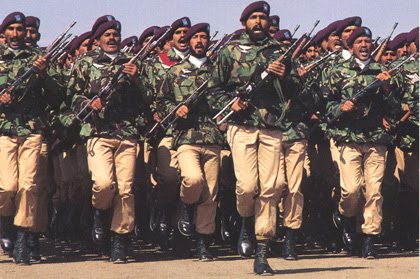The Pakistan Military Academy (PMA) was established at Kakul in October 1947 soon after the creation of Pakistan. On 25th January 1948, “The First Pakistan Battalion” was instituted. Its companies were named after the luminaries of Muslim military history i.e, Khalid, Tariq, Qasim and Salahuddin. Two months later in March 1948, the Battalion was bestowed with Quaid-e-Azam’s patronage as Colonel-in-Chief and the most coveted claim “The Quaid-e-Azam’s Own’ While the Quaid’s failing health prevented him from visiting PMA,
Khawaja Nazim-ud-din, the then, Governor General inaugurated it on behalf of the Quaid-e-Azam and presented the Quaid-e-Azam banner. Ever since, at every passing out parade, it is held aloft with splendid honour by champion company. Regimental colours presented in 1950 by Liaqat Ali Khan, the first Prime Minister of Pakistan and the National Standard in 1961 by General Muhammad Musa, the then, Commander-in-Chief of Pakistan Army, have been some of the honours showered on the Academy, which it has always jealously guarded and kept high in letter and spirit.
The Indo-Pak War of 1965 necessitated Academy’s expansion and Second Pakistan Battalion was raised in December 1965. Its four companies were named after some renowned Muslim military leaders from the subcontinent i.e. Ghaznavi, Babur, Aurangzeb and Tipu. In early 1989, Third Pakistan Battalion was added to its fold. Its constituent companies were named after some very inspiring military generals in early Muslim history i.e. Haider, Ubaida, Saad and Hamza.
The Pakistan Military Academy is very proud of hundreds of its graduates who gallantly fought during the Indo-Pak Wars of 1965 and 1971. Amongst them are the four recipients of Nishan-e-Haider, the highest gallantry award, three Hilal-e-Jurat, one hundred and seventy seven Sitara-e-Jurat, besides innumerable other gallantry awards. Its alumni have vindicated themselves at every moment of trial. They have immensely contributed in vast and variant roles ranging from national defence to national development and from mass relief to national reconstruction in perilous conditions.
The Pakistan Military Academy is very proud of hundreds of its graduates who gallantly fought during the Indo-Pak Wars of 1965 and 1971. Amongst them are the four recipients of Nishan-e-Haider, the highest gallantry award, three Hilal-e-Jurat, one hundred and seventy seven Sitara-e-Jurat, besides innumerable other gallantry awards. Its alumni have vindicated themselves at every moment of trial. They have immensely contributed in vast and variant roles ranging from national defence to national development and from mass relief to national reconstruction in perilous conditions.
PMA has come a long way since its inception in 1947. It has grown and expanded from stage to stage. Over the years, there has been colossal contribution towards improvement of the campus and enrichment of its curriculum. Presently, its facilities and curriculum full cater for all challenges and needs for the foreseeable future.
.jpg)







.jpg)


